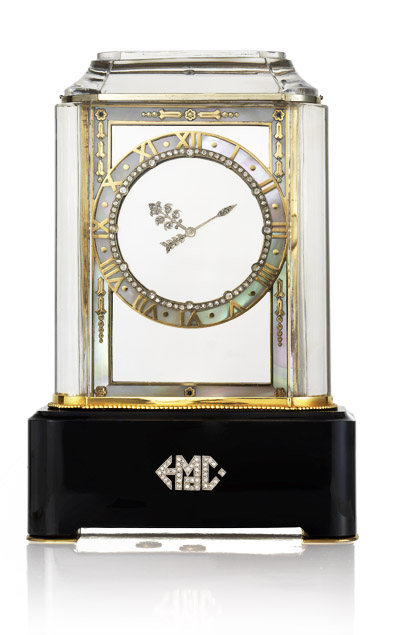The following is an excerpt from Cartier in the 20th Century. This companion catalog to Brilliant, published by the Denver Art Museum, can be purchased at The Shop at the DAM and online.
Since its founding, Cartier’s repertoire has extended beyond jewelry: they retailed pocket and pendant watches, chatelaines (a lady’s accessory designed to hold objects such as keys, a watch, scissors, and the like on chains suspended from a hook or clasp), cane tops, umbrella handles, and even silver services. In the early twentieth century, some of Cartier’s accessories and decorative objects were designed to compete directly with those of Fabergé, which was renowned for its intricate, exquisitely detailed enameled Easter egg presentation pieces made for the Russian imperial family. Cartier began to produce gold, enamel, and hardstone cigarette cases, as well as carved hardstone animal figurines…. Other popular desk and tabletop items produced by Cartier included ornate picture frames, lorgnettes, bell pushes, writing sets, perfume burners, barometers, calendars, and other devices.
Queen Alexandra of Great Britain bought a baroque-style gold picture frame with red and blue enameling around 1905, reputedly as a gift for a goddaughter. J. P. Morgan acquired an elegant neoclassical enameled desk clock in 1905 and a similarly colored picture frame two years later. A very imposing gold frame was purchased by Nancy Leeds in 1910 (above). A decade later (after her husband’s death and the inheritance of a huge fortune) Nancy married Prince Christopher of Greece and Denmark, thus achieving authentic royal status; she took the name Princess Anastasia of Greece and Denmark.
Clocks and Watches
In the 1890s Cartier also sold pocket watches by a number of makers, including Vacheron Constantin. Louis Cartier was reportedly the prime mover in the Cartier firm’s decision at the end of the decade to create a new specialty in fine clock- and watchmaking, a deliberate effort to revive France’s earlier greatness in this field. Working with numerous specialized or exclusive Paris workshops that produced the movements, faces, cases, and other decorative elements, Cartier began designing inventive and colorful desk clocks.
Special features included indications of the days of the week and the months, rotating dials, and diamond motifs such as stars to mark the hours and minutes. Eye-catching materials included engine-turned metal covered with colored enamel, agate, onyx, nephrite, and rock crystal. The first of Cartier’s famous “mystery clocks” was produced in 1912; one was sold to J. P. Morgan Jr. in December 1913.
These clocks have transparent dials in which the hands appear to be suspended and move without any visible mechanism. The early examples had rock crystal dials and cases and restrained neoclassical decoration. (The design remained popular for decades: an example with mother-of-pearl inlay was sold to Evalyn Walsh McLean in 1927.)
Cartier’s early twentieth-century ladies’ watches were produced in flat, ball-shaped, or egg-shaped models with lovely colored-enamel cases that hung from a black cord, a ribbon, or a chain of enamel, diamonds, and pearls. Bracelet watches had cases framed with diamonds and straps of black ribbon, woven seed pearls, or platinum mesh trimmed with diamonds.
Men’s pocket watches were made in numerous styles, including novel models with rock crystal cases or ultraflat movements hidden inside a gold coin. Cartier also pioneered the modern man’s wristwatch, made for the convenience of active individuals such as aviator Alberto Santos-Dumont. Featuring simple gold or platinum cases and plain leather straps, these models transformed watch aesthetics and heralded a new lifestyle.
Image credits:
(Top) Frame Cartier Paris, 1910. Pink and green gold, silver, buff-top calibré-cut sapphires, carved rock crystal, natural pearls. Monogram WBL. Sold to Mrs. W. B. Leeds. 32 × 24 cm. Cartier Collection.
The frame holds a photograph of Nancy Leeds (modern print). She wears a tiara surmounted by seven diamonds created by Cartier in 1913. Born May Stewart (1878–1923), she first married banker George Worthington. Divorced five years later, she remarried tin magnate William Bateman Leeds. Widowed in 1908, Nancy Leeds became an important Cartier jewelry client. In 1910 she made the news by buying a Cartier necklace of pearls and diamond rondelles for $570,000. Her third marriage, in 1920, was to Prince Christopher of Greece and Denmark.
(Center) Model A mystery clock, Cartier New York, 1927. Gold, platinum, rock crystal, rose-cut diamonds, mother-of-pearl, onyx. Rectangular 8-day movement, gilded, 13 jewels, Swiss lever escapement, bimetallic balance, Breguet balance spring. Hand-setting and winding mechanism underneath the base. Sold to Evalyn Walsh McLean. Height 13.6 cm. Cartier Collection. Photo: Marian Gérard, Cartier Collection © Cartier.

